
Cognos 11.1
Report Writer Basics
April 2019
Page 2
© 2019 Kent State University
This information is provided by the Division of Information Technology, Kent State University
and is proprietary and confidential. These materials are made available for the exclusive use of
Kent State University employees, and shall not be duplicated, published or disclosed for other
purposes without written permission.

Table of Contents
Introduction ..........................................................................................................................4
Accessing Cognos Report Studio.............................................................................................5
Report Writer User Interface..................................................................................................8
Building a Report...................................................................................................................9
Adding Data Items .........................................................................................................................9
Validate the Report......................................................................................................................10
Running a Report.................................................................................................................10
Report Display .............................................................................................................................11
Saving Reports.............................................................................................................................12
Opening Saved Reports ................................................................................................................12
Customizing the Report Display............................................................................................13
Edit a Report Title ........................................................................................................................13
Edit a Column Name.....................................................................................................................14
Grouping Results..........................................................................................................................16
Aggregation .................................................................................................................................17
Adding Filters...............................................................................................................................20
Pre-Defined Filters.............................................................................................................................................. 20
Custom Filters..................................................................................................................................................... 21
Prompts and Prompt Pages..................................................................................................26
Prompt Pages ..............................................................................................................................27
Additional Prompts ......................................................................................................................31
Prompt User Interface..................................................................................................................35
Prompt Sorting ................................................................................................................................................... 35
Multi-Select ........................................................................................................................................................ 36
Select UI (User Interface for thePrompt List) ..................................................................................................... 37
Prompt Required ................................................................................................................................................ 37
For additional information regarding Cognos policies and access, or modifications to the ODS,
contact the Business Intelligence Team at [email protected] For technical assistance, contact .
the Help Desk at 330-672-HELP (4357) or support.kent.edu. Additional Cognos training materials
are available at www.kent.edu/it/cognos-resources.
Page 3
Introduction
Agenda
Cognos report Studio is a web-based application designed to allow users to easily create
complex reports utilizing many different sources of data.
The purpose of this training guide is to introduce Report Studio. The course objectives are:
Access Report Studio
Identify key areas in Cognos Consumer
Explore Report Studio
Build and format queries in Report Studio
Accessing Cognos Report Studio
Cognos Report Studio is used in both test and production instances to allow for practice in
creating reports and designing tested and approved reports for public use.
Navigating Report Studio
Cognos Report Studio navigation consists of a selection of Menus, Tools, and Windows to aid
the writing and design of reports.
Report Studios Toolbar
Insertable Objects Window
Work Area
Properties Pane
Creating and Modifying Reports
Creating a Report
Editing Titles
Filters
Prompt Pages
Sorting
Page 4

Accessing Cognos Report Studio
If Report Writer access has been granted, users will be able to create new reports and edit
personally saved reports from Cognos as accessed through FlashLine.
On the Home screen, a button labeled “New” is located in the bottom of the Navigation Menu
panel on the left.
Page 5
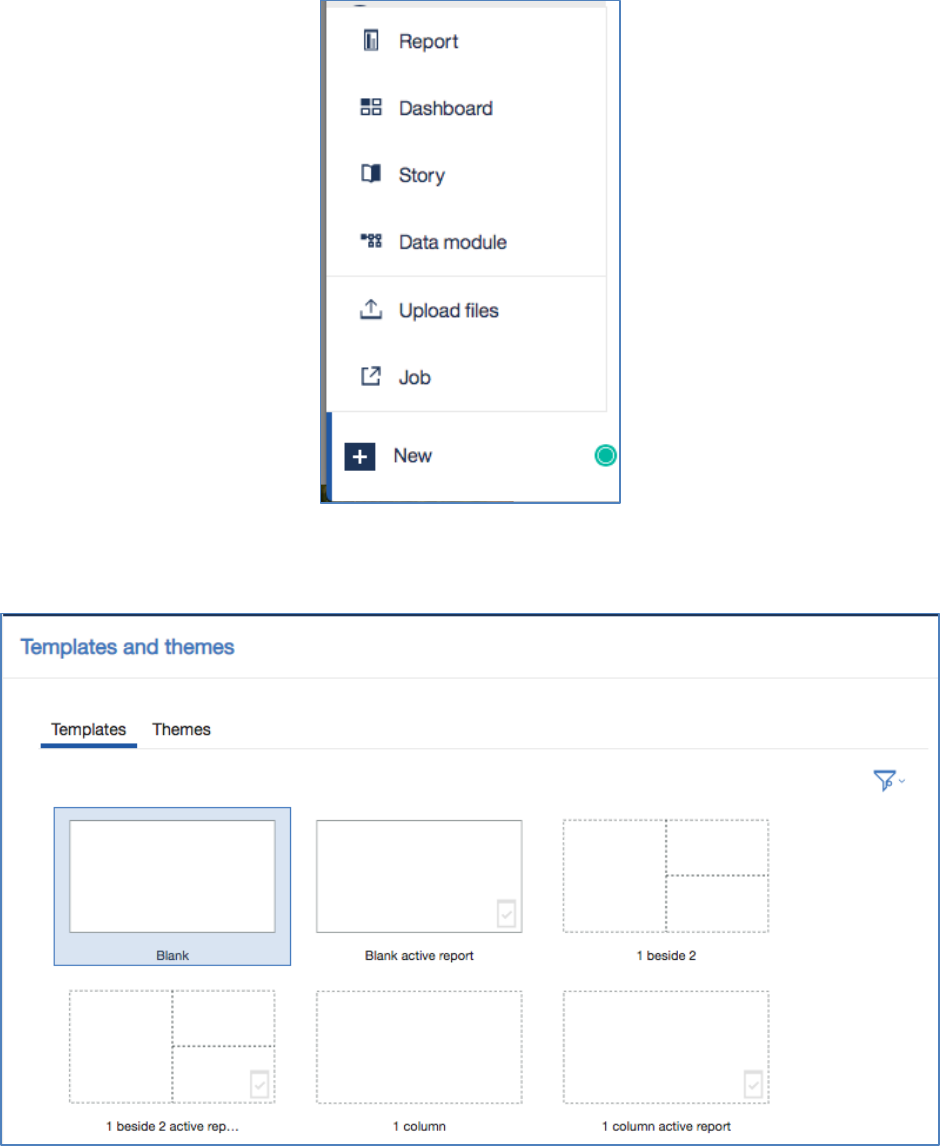
Clicking this button opens a selection panel for choosing what Cognos item is to be created.
Clicking on the desired item will display the Templates and themes window for selection from a
listing of available preset layout templates and color themes. A blank template will allow for a
custom layout.
Page 6
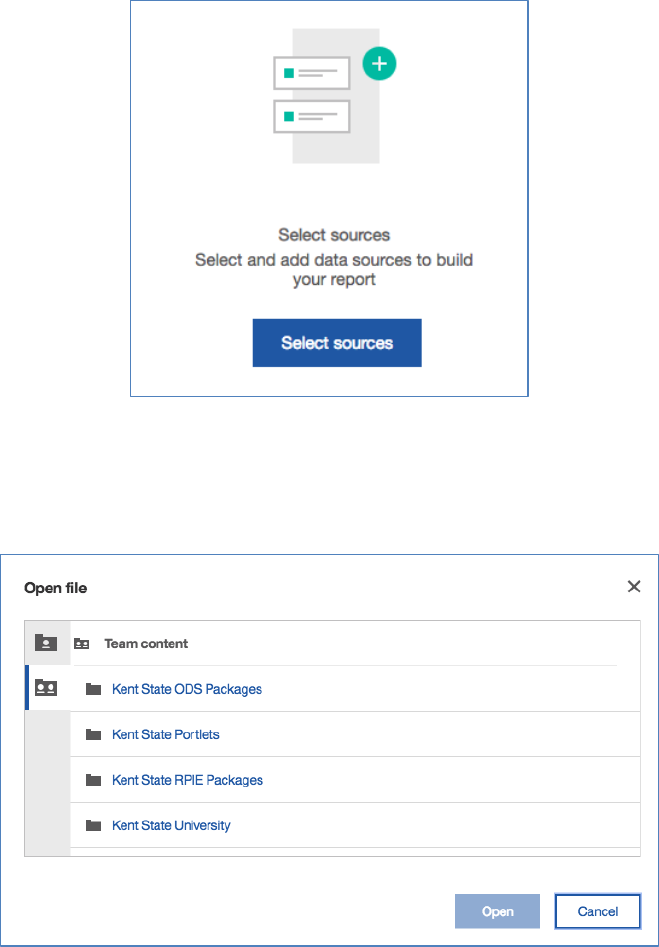
After selecting a report layout, a page will open prompting users to Select sources from which
to retrieve data for the report.
Clicking the Select source button allows users to choose from the data packages available to
them as granted by the Security Access Group.
Selecting the data package and clicking the Open button will create the report page and allow
for adding objects to build the report.
Page 7
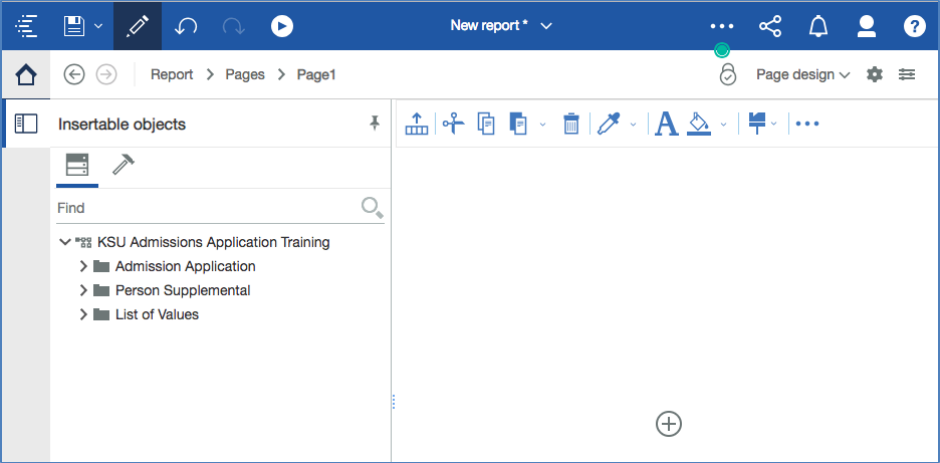
Report Writer User Interface
The working page is designed in several sections. Across the top of the page is a function
banner. Directly below is a Navigation Menu banner. To the left is the Insertable Objects pane,
and to the right is the Canvas, with an additional toolbar specifically for items placed on the
report canvas.
The function banner, across the top of the page, includes several action buttons used in
creating a report in Cognos.
On the left are buttons to save, edit, undo, redo, and run. In the center of the menu banner is a
drop-down navigation tool to toggle between documents. On the right is a More button to
select additional options related to the current page, as well as a button to access notifications.
Below the menu banner of action buttons is a navigation banner offering access to different
pages and views of the report. Included on the left are a home button, previous and next
buttons, and a breadcrumb trail. Further to the right are buttons to lock or unlock items in the
work area, change the page view, manage items in the report, and set properties.
The Insertable Objects pane offers access to data items to be included in the report through the
data sources, data items, and report toolbox.
The report Canvas on the right is the building space for the report items to be added. A set of
design tools is located in a toolbar at the top of the canvas to design, create, and edit the report
items and format.
Page 8
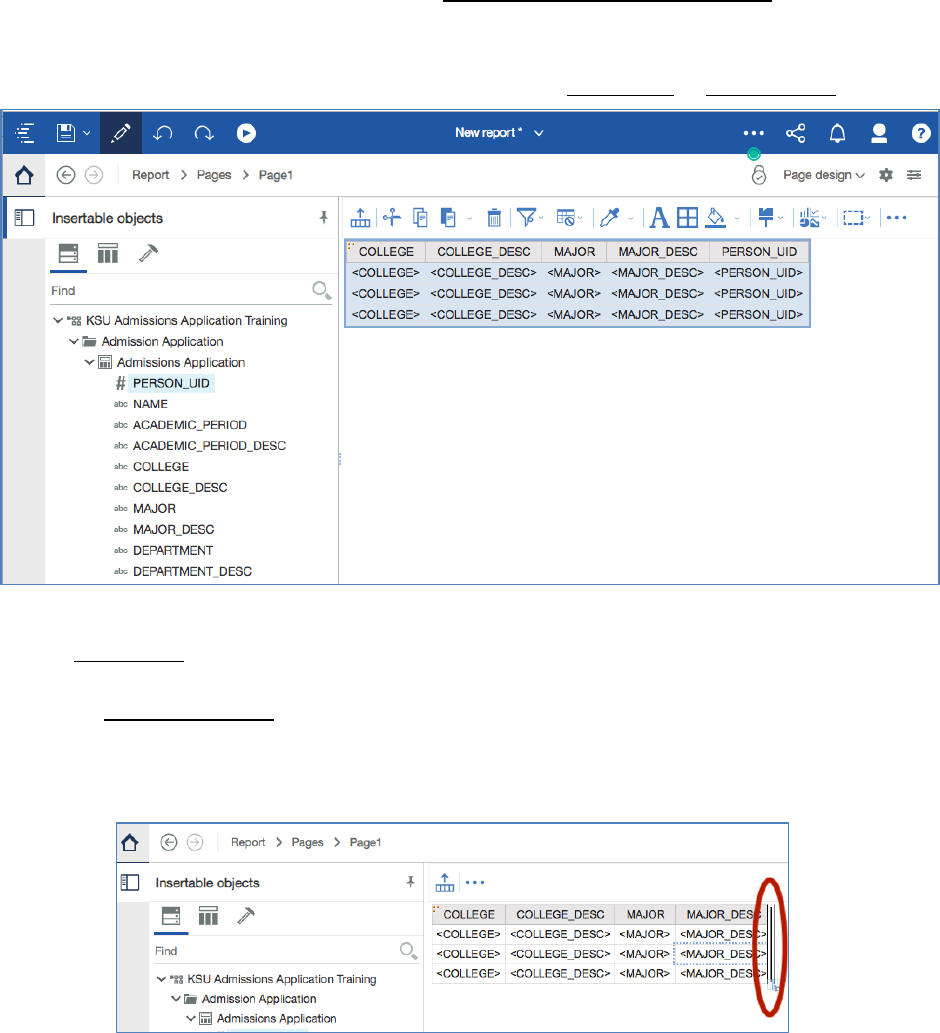
Building a Report
The next section contains information on how to build a report. The formatting options that
will be covered in this section include inserting data items, adding a title, changing column
names, adding filters and prompts, grouping and aggregation.
The first step is deciding what information needs to be displayed in the report. Then, as the
report is created, additional items may be added to enhance the usability of the report.
For this example, we will create a report of a Student Count by College and Major.
Adding Data Items
There are two methods for adding data items to a report; double click or drag and drop.
Either of the following steps may be used to add a data item to a report.
1. Double click on the data item to insert it into the report. If there are data items in the
report, the data item will be added to the right of a selected column.
2. To drag a drop a data item, click on the item from the Insertable Objects Pane and drag it
to the right of where the item should be placed.
NOTE: The item is in the correct spot when the thin line starts flashing.
Page 9
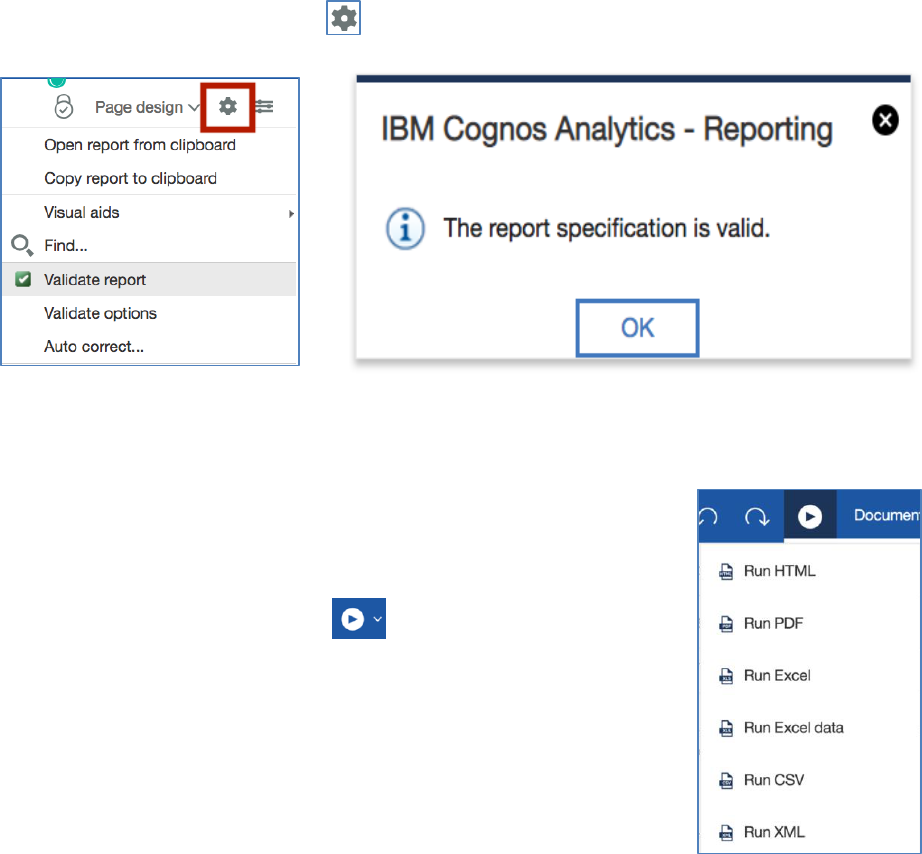
Page 10
Example
Add the following data items to the report from the INSERTABLE OBJECTS PANE, in the SOURCE TAB:
1. College
2. College Description
3. Major
4. Major Description
5. Personal University ID (or PIDM) – (Person_UID = PIDM, the ID = KSU ID)
NOTE: When adding data items, the Code item is more efficient for a query than the
Description. It is best to sort and retrieve data using the Code, and display using the Description.
Validate the Report
Before a report is run, it is suggested to validate the report to ensure it contains no errors.
Clicking the Manage Report button opens a drop-down selection panel to access the
Validate option.
If no errors are present, the report can be run to view the results in a report format.
Running a Report
Because the report data is used at the university in many different
ways, various report formats are often desired. For this, reports can be
produced in a variety of formats, depending on the need of the user.
Clicking on the Run Options button opens a menu of report
format options to be retrieved. A saved report may be rerun in a
different format at any time.
Additionally, at the bottom of the run menu is a selection noted as
Show Run Options, which will allow users to set default settings for
the output of a report.
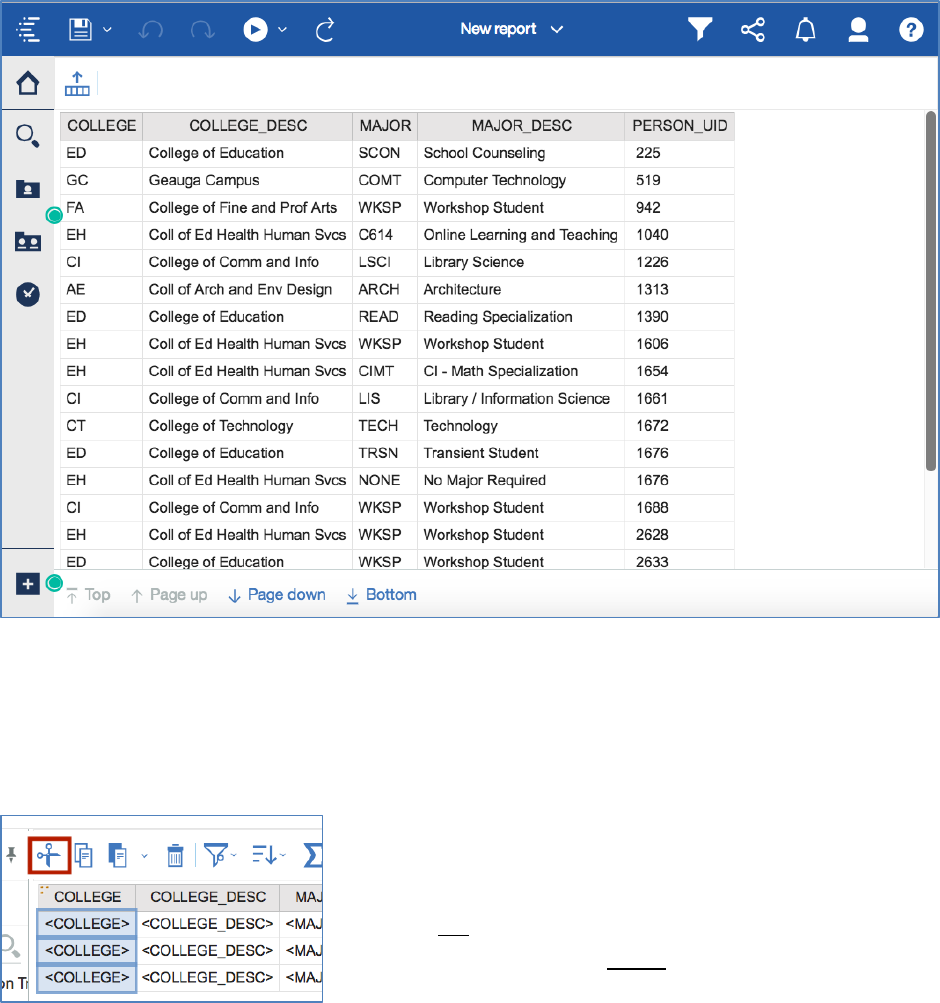
Report Display
Links at the bottom allow for navigation through the pages of the report.
The report retrieves the data based upon the report page.
Though the Code Items work best for retrieving data, they may not be helpful being displayed
on the report itself. These items can be removed from the Report Page without being removed
completely from the report.
CLICK in the column body to select the entire column, and
reveal a pop-up options window. Select CUT from the
options.
Using the Cut feature will remove the Code Item only from
the Report Page. Using the Delete function would remove the
query from the report entirely
Page 11
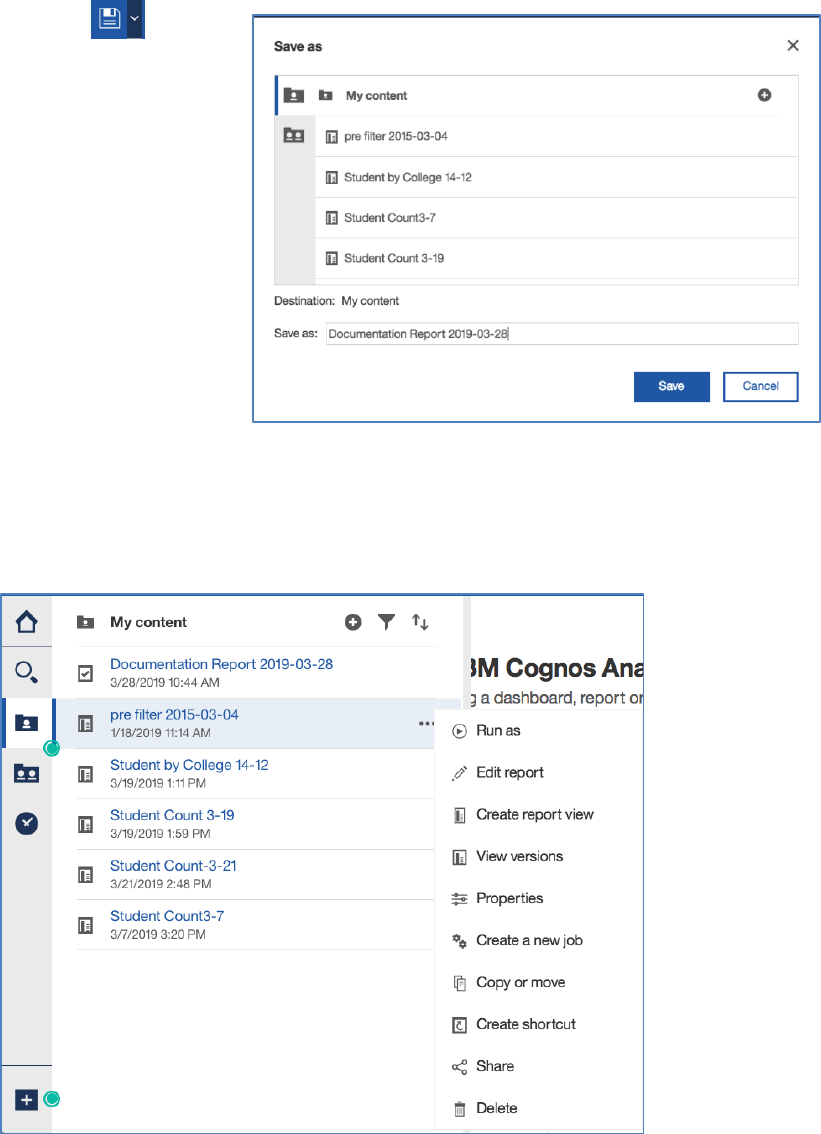
Saving Reports
Saving report versions allows report writers to revisit previous levels of report creation without
the need to develop reports from step one.
Clicking on the Save icon and
selecting Save As allows users to save
the current report view in a specified
location. It is recommended to save
items in the My content folder and
naming the report for future access.
Opening Saved Reports
Once a report has been saved to the My Folders tab, it can be easily accessed to be run based
on updated data, or opened to be edited or modified, among other options, by clicking the
more options, or 3-ellipses button and selecting from the dropdown list.
Page 12

Customizing the Report Display
Edit a Report Title
Report Studio allows the author to add and format report titles and column headers for a
customized report view that is easier to read. The report title is referred to as the Page Header
and can be added by clicking the Page Ellipses button, choosing the Headers & footers option,
and selecting Page header & footer.
If a pop-up window appears, the check box can be selected for Header, and clicking the OK
button will create the Title Header on the report page.
A Header Insert button will appear at the top of the report page. The type of header can be
chosen by clicking the button.
Page 13
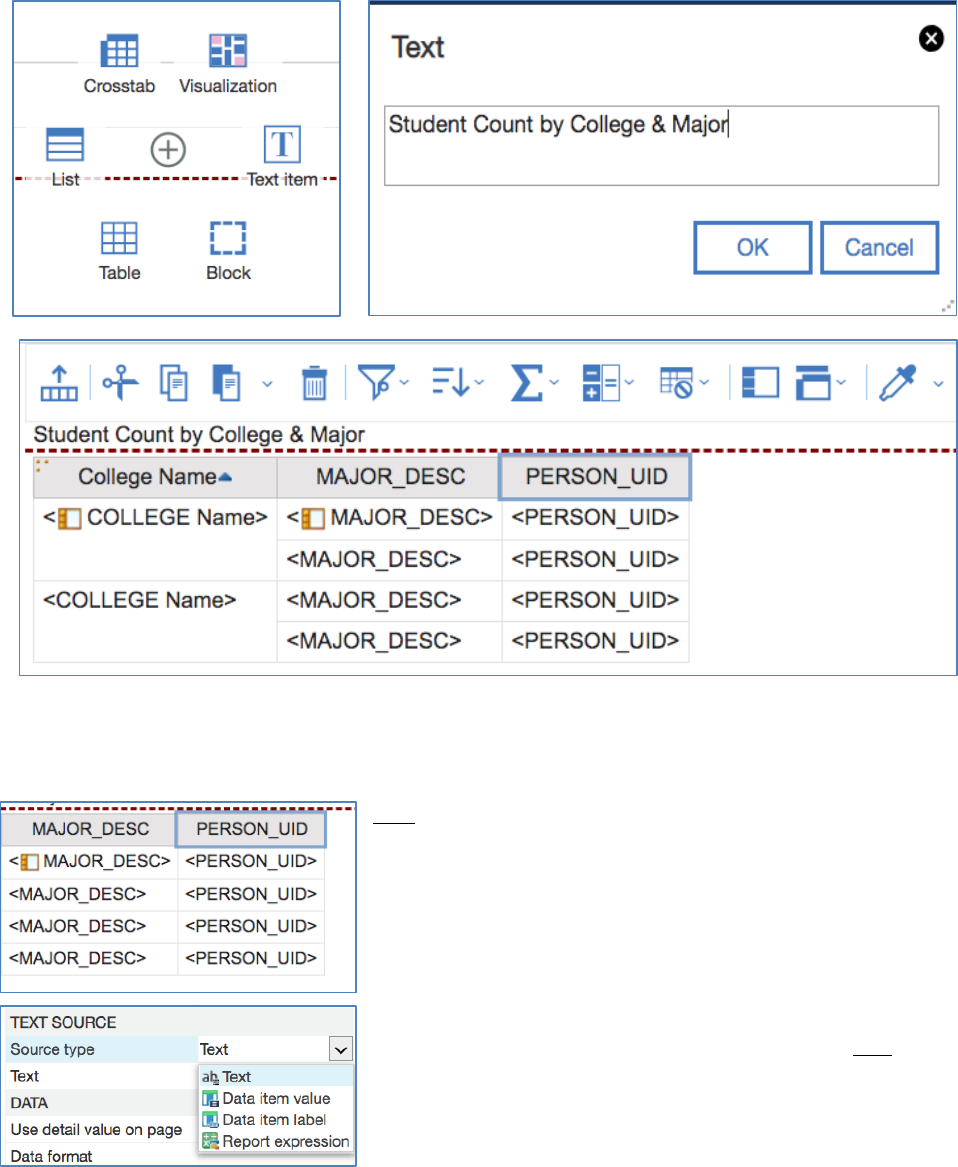
A variety of items will appear for selection. Most commonly the Text item is used, and a
Heading can be typed in.
Edit a Column Name
To make the data more professional, column headers may be changed to reflect the data.
Click on the column header to be changed. The properties
for the cell will appear in the Properties Window.
In the Source Type selection, click on the label to reveal the
options drop-down box and select the option for
Text.
Page 14
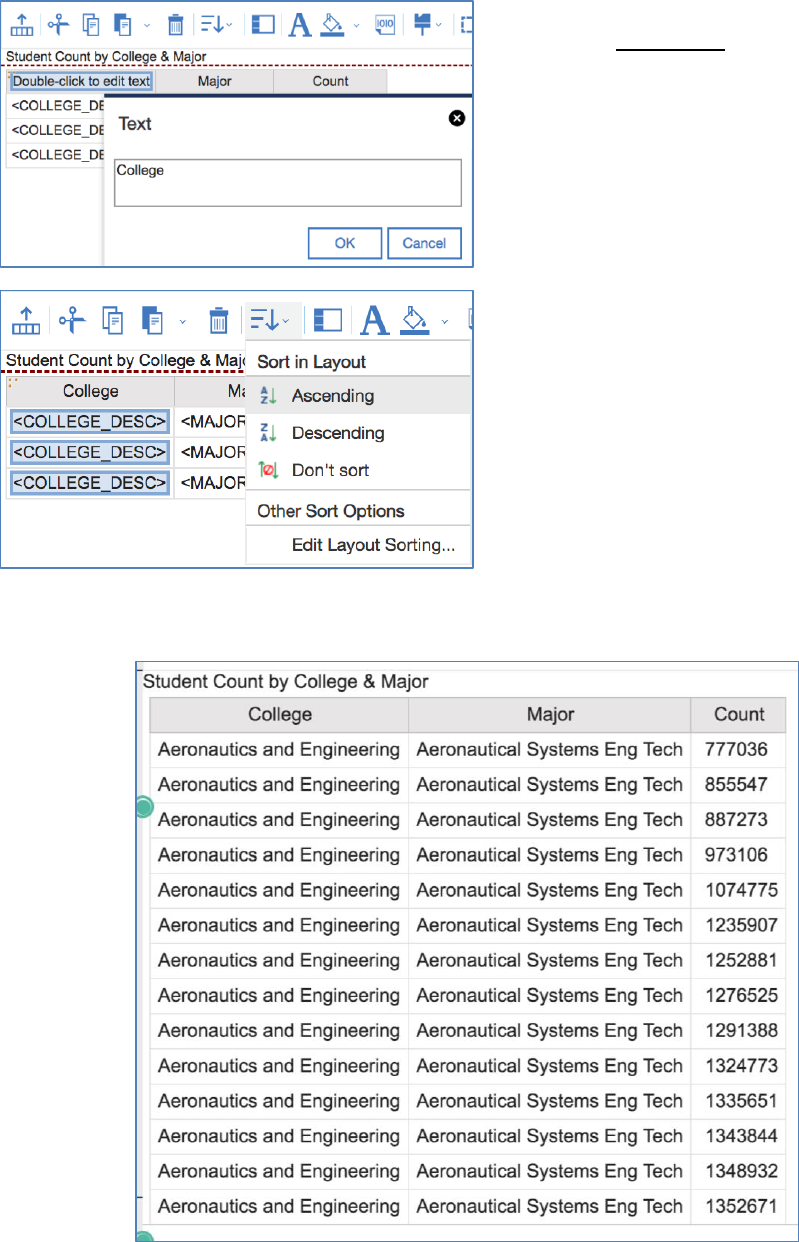
The column heading will change to a message
indicating to
double-click to edit the text.
A Text box will open for the entry of the new
column heading.
Continue through the remaining column
headings as necessary.
It may also be helpful to organize the Report
Page. Selecting the column body, clicking on
the SORT BUTTON in the Toolbar, and choosing
ASCENDING wil assure the column is presented
in alphabetical order.
This yields a more easily readable report.
Page 15

Grouping Results
Grouping data in the Report page,
simplifies the report by showing each
item only one time.
Click in the column for the data group
item. Use the Structure option in the
Menu Bar or click on the Group/Ungroup
button in the toolbar to show the same
items together.
Continue to group additional data items as needed to create sub-groups.
The page is now grouped first by College, and then each College is grouped by Major. When the
report is run the results will display the grouping.
Page 16
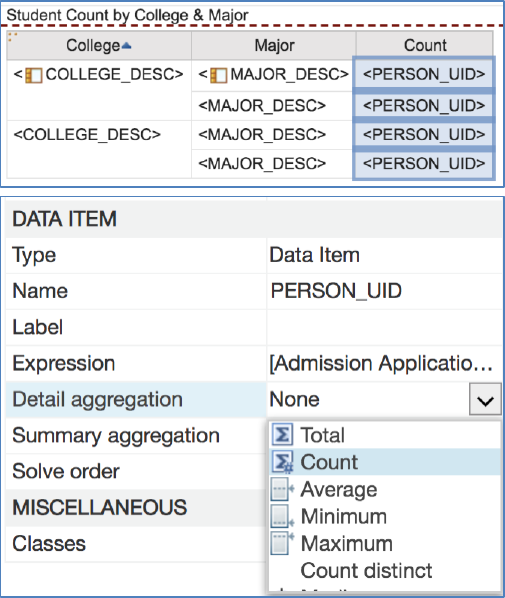
Aggregation
One of the features of Cognos Report Studio is the ability to Aggregate, or summarize, data
from grouped items. This helps the user more easily analyze the data.
Some of the more common types of aggregation are:
1. Total Sums the items in the group
2. Average Averages the items in the group
3. Minimum Displays the lowest number in the group
4. Maximum Displays the highest number in the group
5. Count counts the number of items in the group
One way to add aggregation is to edit the properties of the data in the e Properties Pane.
Click in the column body of the selected
item to be counted.
In the Properties Pane, and the DATA
ITEM section, the drop-down selection
button for Detail aggregation can be used
to choose Count from the list.
Page 17

Example
The report now displays a count of the number of students in each major by college.
To make the report more useful, Totals can be added by group.
Again, returning to the report page, the Count column can be
clicked to select the data. Then, clicking the Sum button in the
toolbar, which is the Greek letter Sigma, a drop-down list appears.
Choosing Total will deliver the total of the selected data.
Page 18
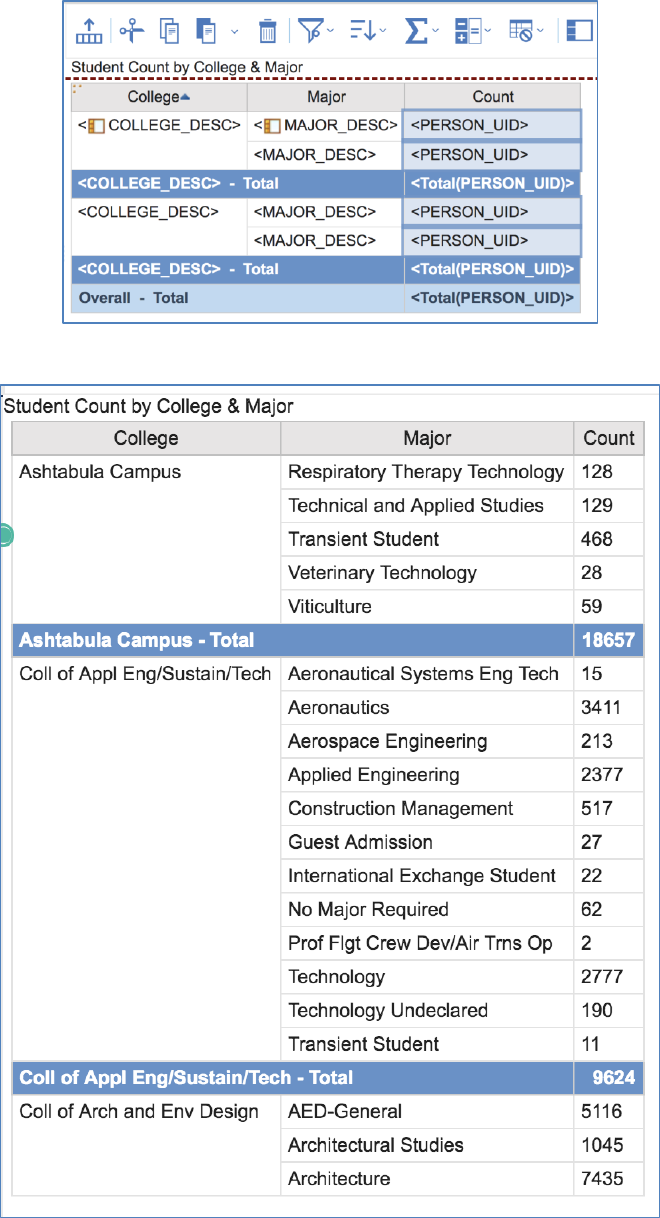
This will create a Total Student Count at the bottom of the report as well as Sub-Totals for each
College and Sub-Totals for each Major.
Running the report at this point will display a much more useful report.
Page 19
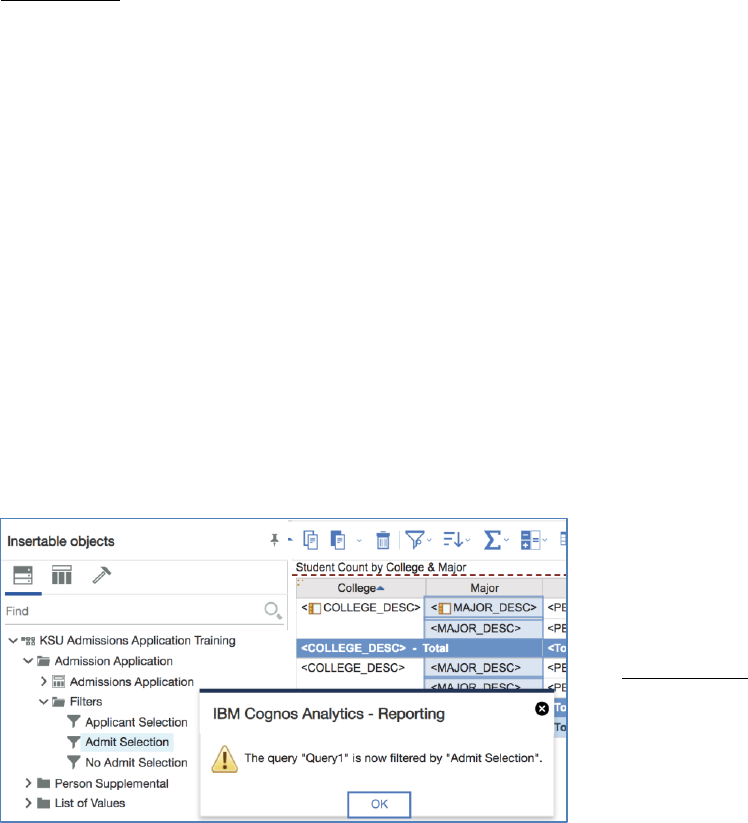
For Example:
Adding Filters
Adding a filter to a report will aid in assuring that the results retrieved include or omit certain
parameters, such as an academic period. The author can build a custom filter, or pre-defined
filters may be available.
A filter is built in terms of an Expression, comprised of
1. A data item to be the filter subject
2. An operator showing how to compare
3. Object data or value
[Admission Application].[Admissions Application].[ACADEMIC_PERIOD] = '201480'
Namespace Query Subject Query Item Operator Value
Common operators are:
= (Equal to) - Precise match
<> (Not equal to) - Shows everything EXCEPT the match
IN - Matches a list of items
NOT IN – Shows everything EXCEPT the matches
STARTS WITH – Retrieves everything that begins with the characters
CONTAINS – Retrieves everything that includes the characters
IS MISSING – Retrieves blanks
Pre-Defined Filters
Pre-defined filters will be located in
the Insertable Objects pane.
1. Locate the pre-defined filters in
the Insertable Objects to which
you have access.
2. Double-Click on the desired
filter to limit the report results.
3. A message will appear stating
that the pre-defined filter has
been added.
4. Click OK.
Page 20
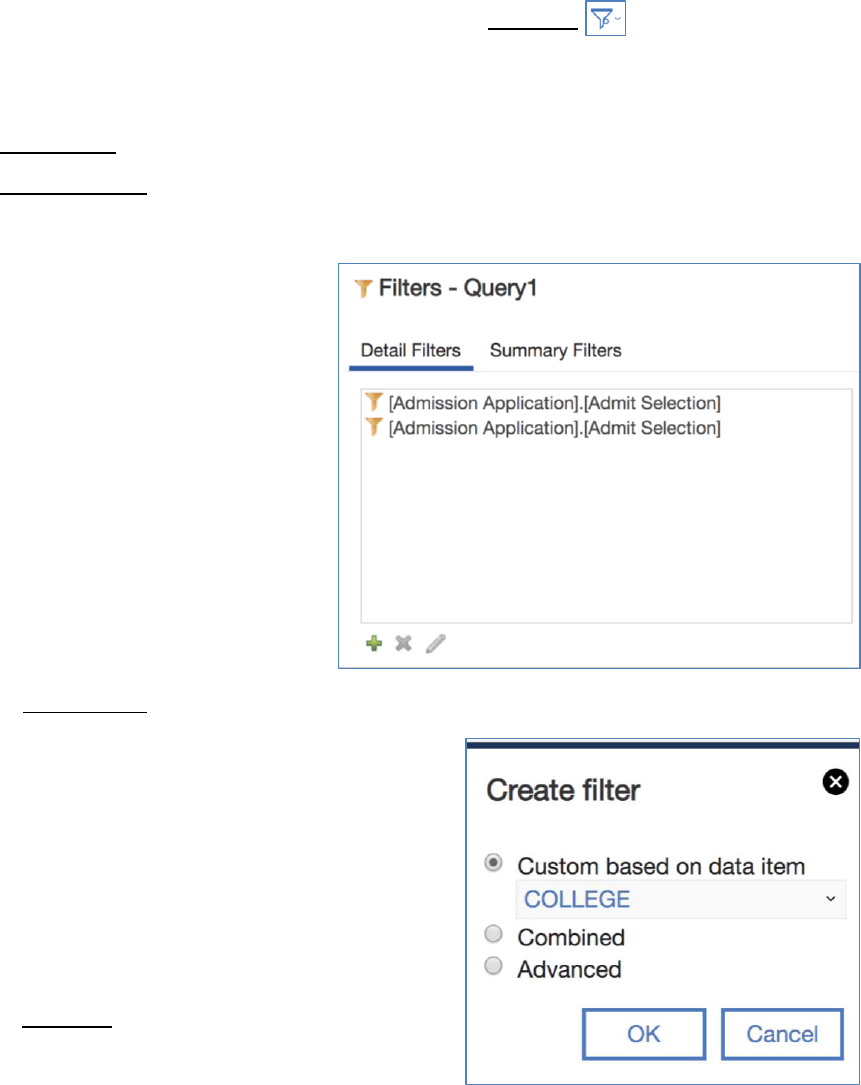
Custom Filters
If greater filtering is desired, a custom filter can be created to further limit the data retrieved.
Additional filters may be added from the Toolbar, via the
Filter Icon and selecting
E
DIT FILTERS.
The Create Filters window will appear displaying any current Detail Filters or Summary Filters.
Detail Filters will affect what data is retrieved to create, or the rows of the report.
Summary Filters affect the grouped, or aggregated data of the report once it is written.
Three buttons at the bottom of the Filters window allow the author to:
Create New Filters
Delete a filter
Edit a current filter
Choosing Create a New filter offers options of:
Custom based on data items: that have been chosen
from the insertable objects pane
Combined: if multiple filter conditions are required
Advanced: if a singular custom filter is desired
Selecting
Advanced allows the author to build a filter
with a wide range of parameter options.
Page 21

With Advanced chosen, components can be added to create the filter either by typing the
code into the Expression Definition pane, or by using the Component Selection Tools to
aid in building the filter.
Source: The Source tab allows for the filter based on any item in the package.
Data Items: The Data Items tab allows for filtering by items in the report.
Queries: The Query Items tab allows filters based on items from other queries in
the report.
Functions: The Functions tab allows for the creation of filter calculations.
Parameters: The Parameters tab allows the use of the input derived from users
based upon answer the parameter.
Macros: use Macros, or condensed instructions, as filters.
Page 22
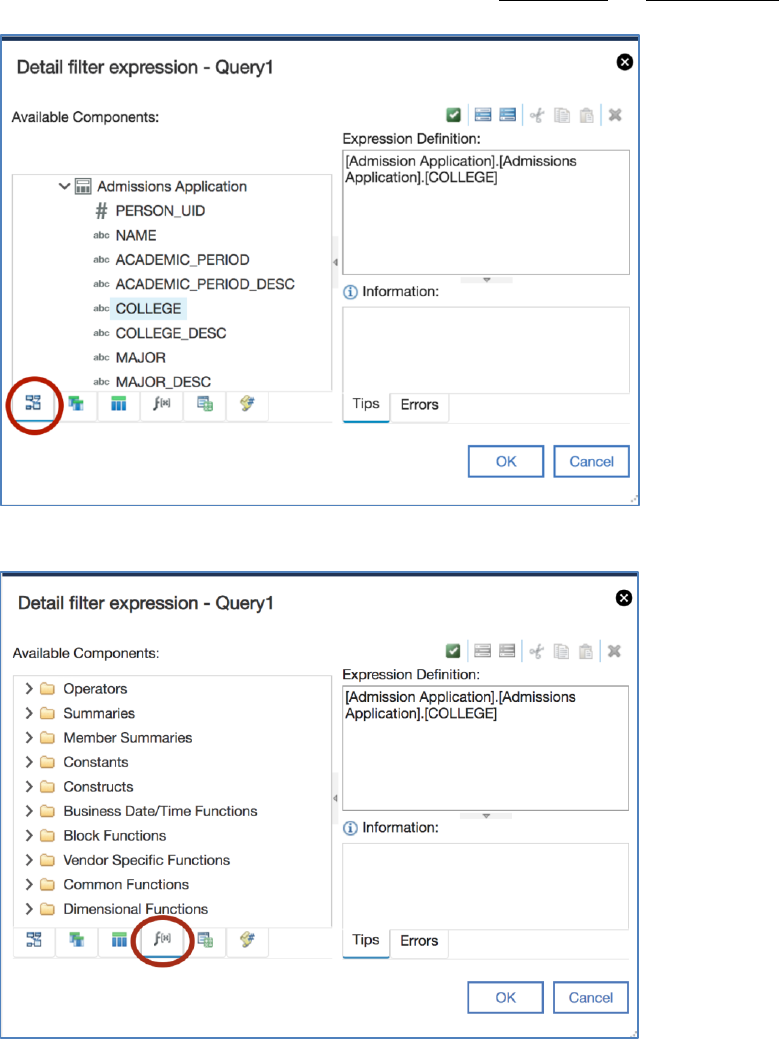
In the SOURCE tab, a data subject can be selected to use as a filter. Double click, or drag-and-drop
the item to add it to the E
XPRESSION DEFINITION.
The Function tab can be used to select an operator.
Page 23

From the Operators List, several comparative options are available. A double click on the
desired operator will add it to the equation.
Finally, a comparative value must be entered to complete the filter equation. The value may be
typed into the equation or selected from the Tools tab in the Available Components pane.
For this example:
1. Select the Source tab.
2. Click
once on the COLLEGE item
3. Click on the S
ELECT VALUE button to see the options for the chosen data item.
4. Select “AC” to choose the Ashtabula Campus
5.
Click Insert to add the filter for the Ashtabula Campus.
The equation should read: [Admission Application].[Admissions Application].[COLLEGE]=’AC’
Page 24
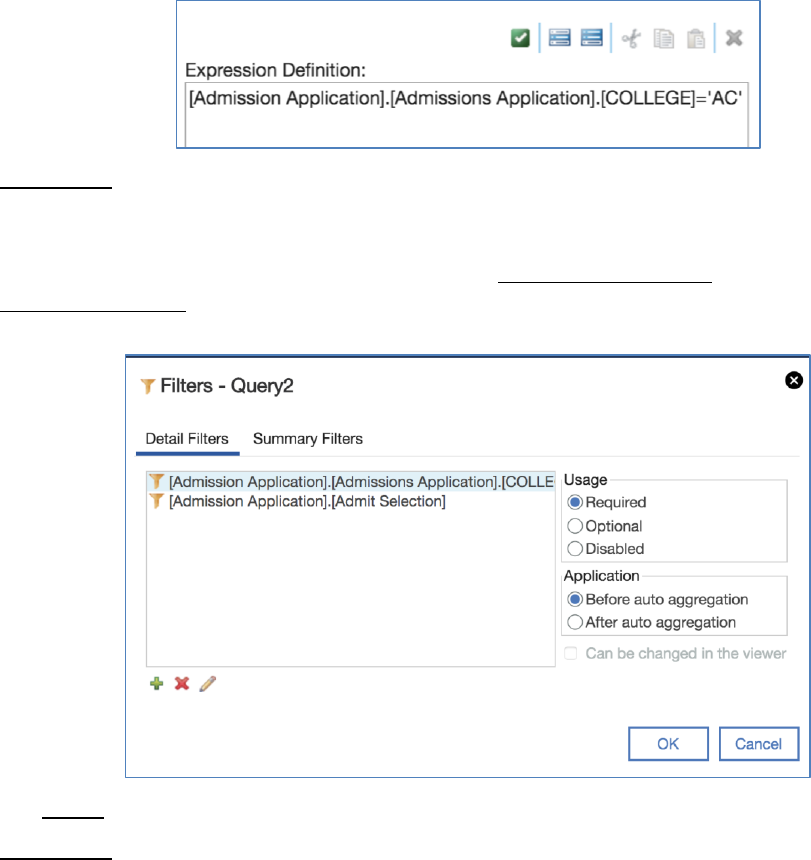
The Validate button can be used to verify no errors are present in the expression.
Please note: For the “ = “ operator, the value is contained in single quotation marks. If
expressions are being manually typed, other operators require different punctuation.
Tw filters have now been added to the data query, Academic Admissions, as well as the
Ashtabula Campus. Clicking the OK button will close the filters window and allow the report to
be run based on the limited request for data.
The Usage field allows the report author to mark a filter as Required, Optional , or Disabled.
Please note: For this exercise, please mark the COLLEGE filter as disabled and click OK.
The report should be saved after making changes.
Page 25
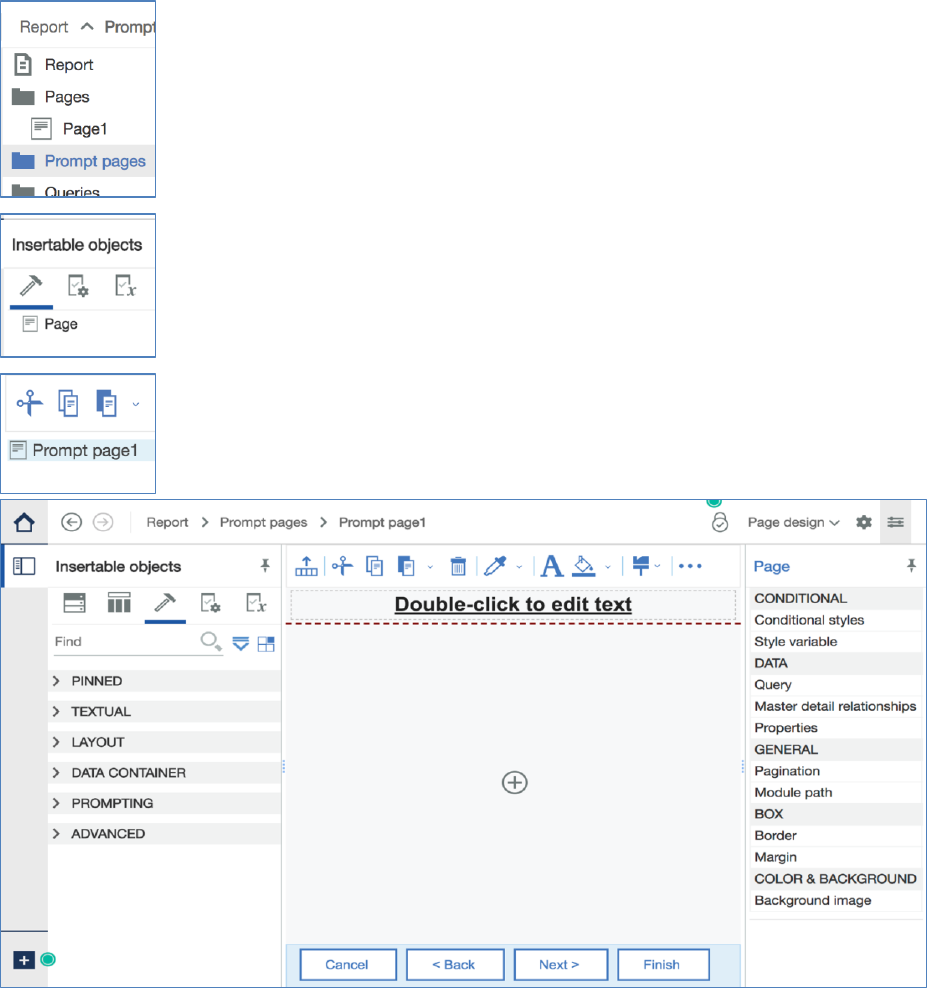
Prompts and Prompt Pages
When filters are used in a report, the filtering criteria remain static. This may be useful for a
basic report that is run based on simple data. Prompts are filters that allow the user to select
the refining criteria each time the report is run. They allow for dynamic changes to the report
based upon the user response.
A Prompt Page can be created as part of the report to guide the user through filtering options
that will generate a more customized report as defined by the user choices, to request more
specific information.
From the Report option of the pages banner, clicking the drop-down menu
and selecting Prompt Pages will display applicable items for the report.
Double-clicking on the Page tool in the insertable object pane opens the
Prompt Page selections to be opened.
Double-clicking on Prompt Page 1 will open the prompt page for
customization.
Page 26

Prompt Pages
To build a prompt page, a table is needed to create spaces to hold the prompts.
Prompts are located in the TOOLBOX tab of the Insertable Objects
window. The author can insert any of the prompt types that are
needed to allow the user to filter the data for the report.
From the Layout options, dragging the Table item onto the canvas will display a selection
window to select the layout of the prompt page table. Most commonly, Prompt Pages are
designed with 2 columns. The number of rows depends upon how many prompts will be added.
For this example, select 2 columns and 10 rows.
Page 27
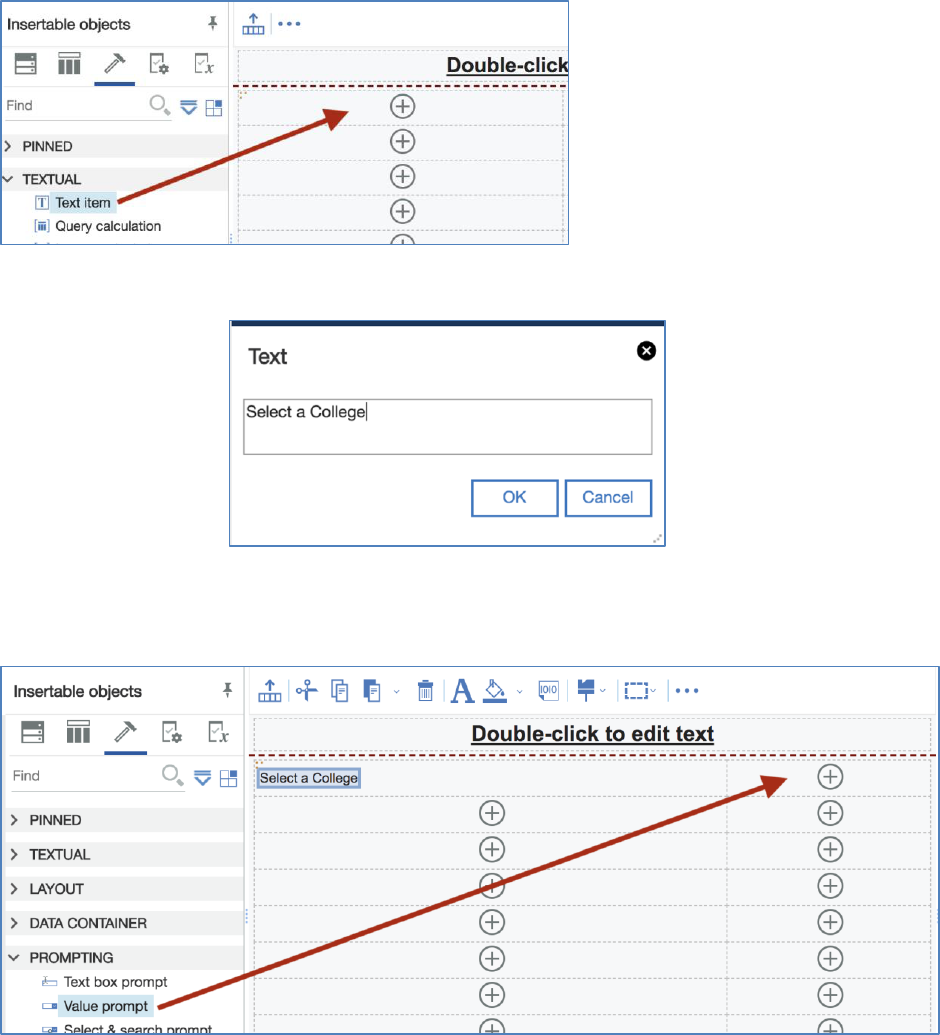
Items from the Insertable Object window are added to the Prompt Page via drag-and-drop.
Usually the first column is used for Text Items, designating what the user will select, and the
second column houses a prompt for a selection from the user based on desired criteria.
In the TEXTUAL objects, the Text Item option may be dragged and dropped into the first cell of
the table. In the text item window type a description or direction for the user.
In the second column, a corresponding Value Prompt, located in the PROMPTING objects,
should be added to designate the filter parameters of the prompt. This will start the Prompt
Wizard to aid in setting the parameters.
Page 28

Name the new parameter consistent to the
corresponding description from column 1. This
will help with navigation should modifications
be needed at a later time. Click NEXT to
continue.
In the Create Filter window, click on the
ellipses button to select the Package Item
from which to retrieve the data.
Select the desired item and click OK.
Page 29

Using the Drop-Down arrow, select the
Operator with which to filter the data. For this
exercise, select
“in”. Click the NEXT button.
Recall Adding Filters on PAGE 21
Finish the prompt filter:
1. Name the query for consistency.
2. Select values to use for data retrieval.
3. Select the display values for the Prompt Page.
*Please Note: When adding data items, the
Code item is more efficient for a query
than the
Description. It is best to sort
and retrieve data using the Code, and
display using the Description.
For this exercise:
1. CollegeQuery
2. [Admission Application].[Admissions Application].[COLLEGE]
3. [Admission Application].[Admissions Application].[COLLEGE_DESC]
Click F
INISH
The Prompt Page has now been created with a single prompt that will allow the user to select
one or more options from the list of colleges to retrieve data in populating the report.
Page 30

Additional Prompts
Additional prompts may be added to allow the user to filter even further. Following similar
steps, a filter for the Academic Period can be offered. Note there will be an additional step in
the process.
Add the descriptive text in column 1.
Add the Value Prompt in Column 2 to display the Prompt Wizard.
Page 31
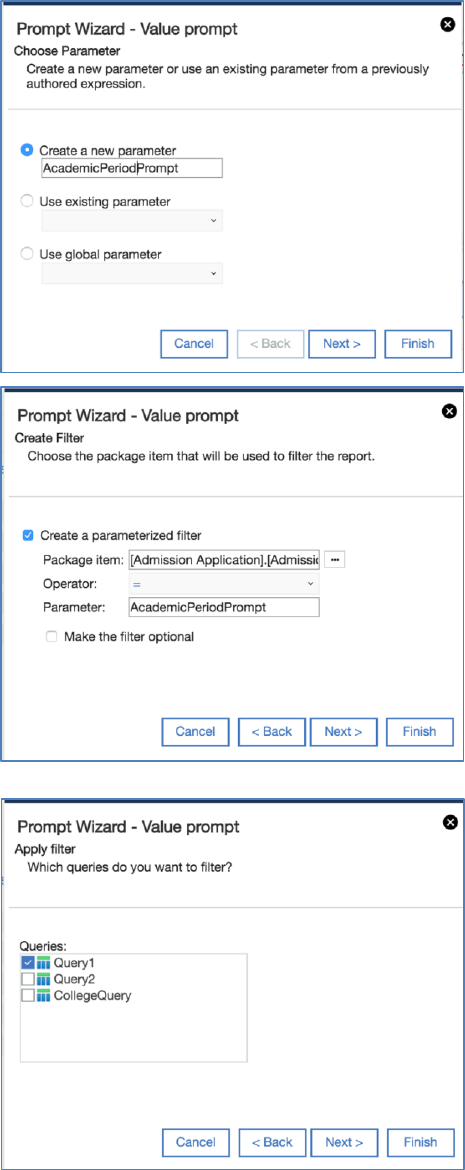
As before, name the new parameter and click
the Next button.
Select the Package Item and the Operator.
Select Academic_Period for the Package Item.
Select the equals sign as the operator to allow
only one term to be selected by the user.
With multiple prompts, an additional window
will appear for the author to designate which
queries to filter. In most cases you will use a
prompt to filter the query for the entire
report, by having the check-box selected for
“Query 1”.
Click N
EXT to continue.
Page 32

Finish the prompt filter:
1. Name the query for consistency
2. Select values to use for data retrieval
3. Select the display values for the Prompt Page
For this exercise:
1. AcademicPeriodQuery
2. [Admission Application].[Admissions Application].[ACADEMIC_PERIOD]
3. [Admission Application].[Admissions Application].[ACADEMIC_PERIOD_DESC]
Click F
INISH
The Prompt Page now has two prompts for the user to utilize for filtering when creating the
report. The first will direct them to choose
at least one College, with the option of selecting
several. The second guides the user to select
only one Academic Period.
Page 33

Running the report requires the user to use the prompts to decide on the filters to be added to
the data to restrict the retrieved information and narrow the results.
Modifications to queries and prompts can be completed by using the
Report drop-down menu to select the appropriate item to navigate to a
window for each.
Page 34
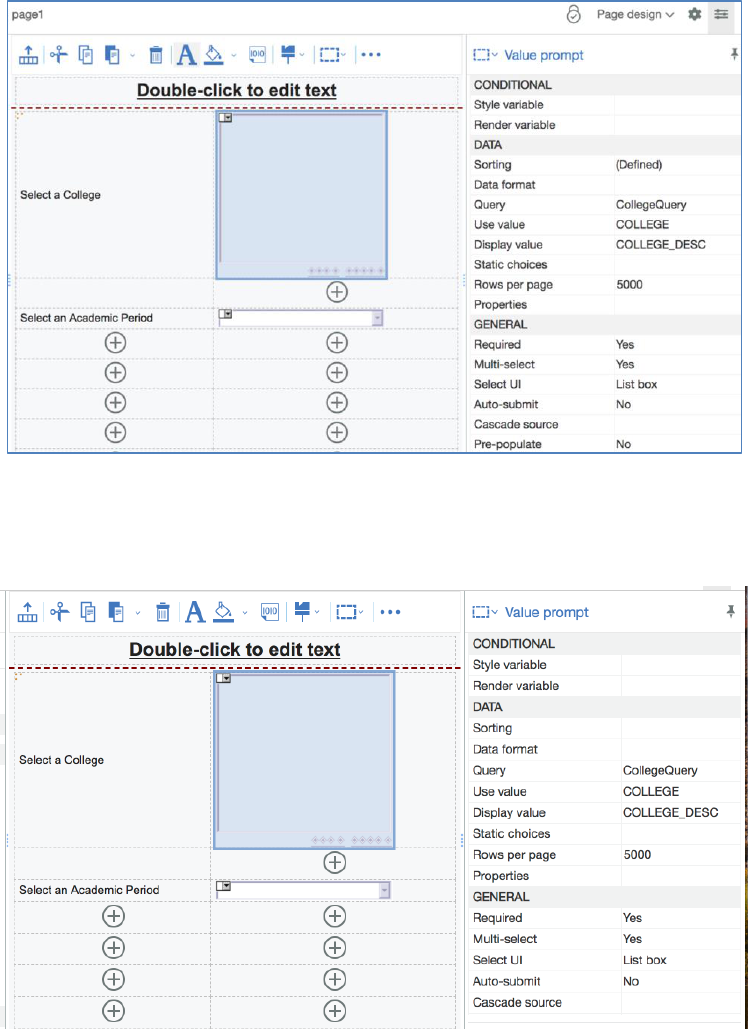
Prompt User Interface
Many options are available for how the prompts are displayed to the report user. These can be
accessed by selecting the data item and clicking the Properties button to edit the preference.
Prompt Sorting
Selecting the College Description data item in the prompt page and clicking the Properties
button, displays the specifics for the selected data.
Page 35
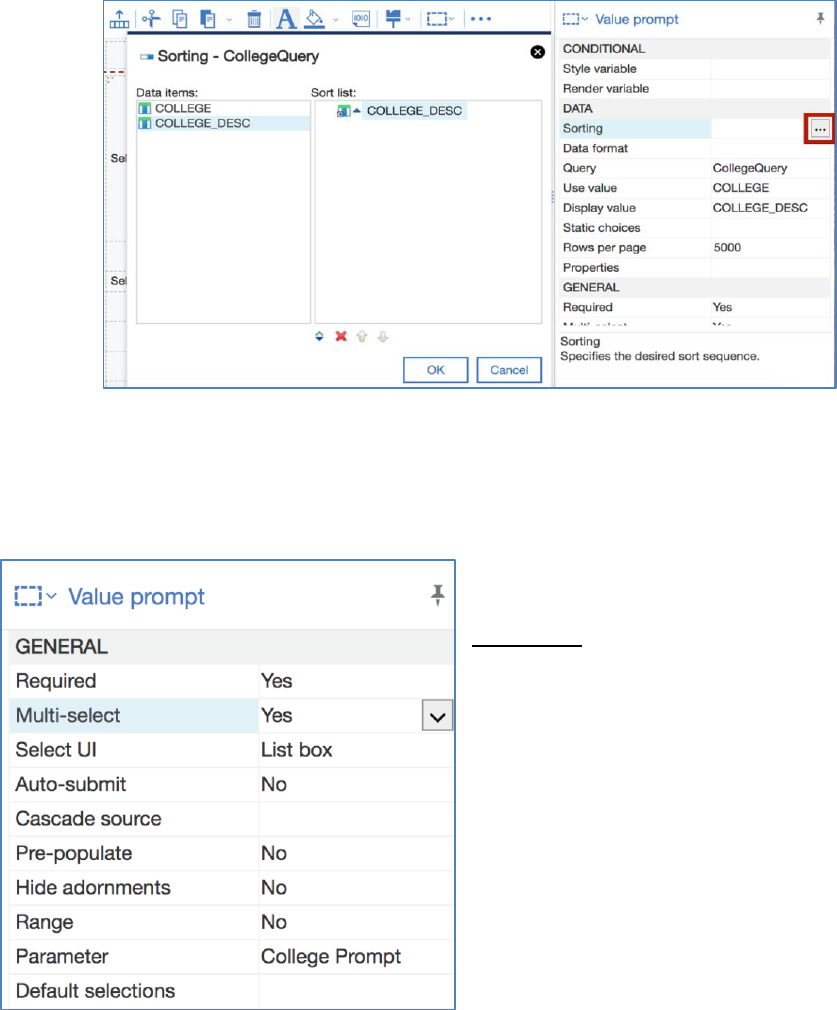
Properties can be edited by changed by using selection menus in the field to the right of the
specific property.
Sort gives the option of alphabetizing the Prompt filter for College Description, making it easier
for the user to locate the appropriate information.
Multi-Select
Click on the COLLEGE VALUE field to select the
item and display the Properties Pane. The
Multi-Select option will allow the author to
easily change whether the user can select one
item or more than one item through the
Prompt Page when running the report.
Page 36
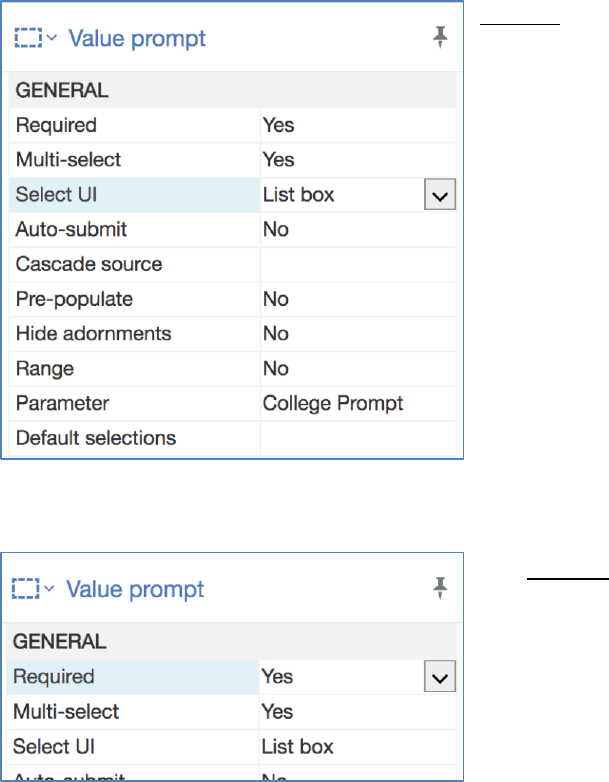
Select UI (User Interface for thePrompt List)
Select UI options, with multi select, allow the
writer to choose whether the user chooses
filter options in the Prompt Page by clicking on
the selections or marking a check box.
Prompt Required
The Required option allows the author to
designate whether or not a particular prompt
Filter is required to be chosen in order to run
the report.
Page 37
